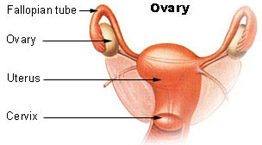
Well, well, well...it turns out that an organ in women long considered useless ("a vestigial structure") actually has a purpose. A recent study found that the rete ovarii may have an important role in the function of the ovaries, and therefore fertility.
The rete ovarii has 3 regions and responds to hormonal signals. It is a horseshoe-shaped network of tubes nestled beneath the ovary.
The study used female mice, but the researchers think the results also apply to humans. Other species of mammals (e.g., cows, sheep, dogs, cats, monkeys) also have a rete ovarii.
From Live Science: 'Useless' female organ discovered over a century ago may actually support ovaries, study finds
An unsung appendage in the female body, which has long been considered useless, may actually be essential for ovary development and fertility, a new mouse study finds.
This structure, called the rete ovarii, was first discovered in humans over a century ago, but until now, it was considered a so-called vestigial structure — not crucial in adult female anatomy, but a leftover from fetal development. Vestigial anatomical structures, or "vestiges," are generally thought to have once had a crucial function that was later lost in the course of human evolution.
But according to a new study, published March 19 in the journal eLife, the rete ovarii (RO) may actually play an important role in ovarian function, and therefore, fertility. The work also showed that the structure has three distinct regions and may respond to hormonal signals.
The female reproductive tract is often thought to consist of the vulva, vagina, cervix, uterus, oviduct, and ovaries," the researchers wrote in their paper. "We suggest that the RO be added to this list and investigated as an additional component of female reproductive function."
Although their study is based in mice, the researchers think it likely applies to people because the structure is also present in a number of other mammal species, including cows, cats, sheep, pigs, dogs and monkeys. Additionally, humans and mice share similar early sex-organ development pathways, so the scientists assume that the structure and its developmental cues might be similar in humans.
The RO is a horseshoe-shaped network of tubes nestled beneath the ovary, at the site where blood vessels and nerves enter the organ. However, despite the structure being highly conserved among mammals, when it was first found in humans in 1870, scientists deemed it to have no use.
When this structure was first discovered in the late 1800s it was assumed that it had no purpose because scientists couldn't see its function within the body," Adam Taylor, a professor of anatomy at Lancaster University who was not involved with the recent study, told Live Science in an email.
At the time, "scientists also didn't have the same imaging, microscopic and molecular techniques available today," Taylor added. "These enable us to detect changes in blood flow, size changes of internal structures during life or ability to detect the proteins produced by the rete ovarii and compare these to similar ones produced elsewhere in the body where the function is known."
Now, in the new paper, researchers have applied modern methods to grant new insight into the RO. Some of their experiments used living mice, so that the researchers could study how the RO develops in the womb. Other tissues analyzed in the study were collected from euthanized animals after death.
The study found that the RO contains three distinct regions that mature during fetal development and then are maintained in adulthood. These regions include the intraovarian rete (IOR), located within the ovary itself; the extraovarian rete (EOR), made of convoluted tubules that join up into a bulb at one end; and the connecting rete (CR), a transitional zone between the IOR and EOR.
Using mass spectrometry — a technique used to identify and quantify molecules — the researchers discovered that, at birth, the EOR contains thousands of proteins within its tubes that its own cells appear to produce. One protein was insulin-like growth factor-binding protein 2 (IGFBP2), may be involved in ovary function. The protein may modulate the availability and activity of insulin-like growth factors (IGFs), which are structurally similar to insulin and important for the development of the follicles that carry immature eggs and hormones in the ovary.
In other experiments, the researchers watched fluorescent dye move through the EOR, revealing that fluid within the EOR is propelled toward the ovary. This further suggests that the RO has a role in ovarian function.
In another analysis, they found that the cells of the RO expressed, or switched on, genes that code for a variety of hormone receptors, including receptors for the sex hormones estrogen and progesterone. These hormones play important roles in female reproduction and health, helping to orchestrate the menstrual cycle, among other jobs.
"It appears that the rete ovarii may have a role in ovarian homeostasis - maintaining the ovaries and their environment," Taylor suggested. "Similarly they appear to be able to detect fluid movement in and around the ovaries and their microenvironment. Finally and most interestingly is the potential endocrine [hormonal] role that the rete ovarii may have."
The researchers behind the study suggest that the EOR may "act as an antenna" to receive signals from the rest of the body, both via hormones and nerves, and then send that information on to the ovary via the proteins it secretes and transports.
"There's still so much we can't even begin to comprehend about female anatomy," study lead author Dilara Anbarci, a developmental biologist at the University of Michigan, told Science News. "I hope this encourages more investigation in reevaluating what we don't already know about the ovary."
This research challenges the traditional view of the RO being considered redundant, proposing instead that it has a secret wealth of functions. Figuring out how the rete ovarii works could one day help scientists better understand and treat conditions of the female reproductive system.
